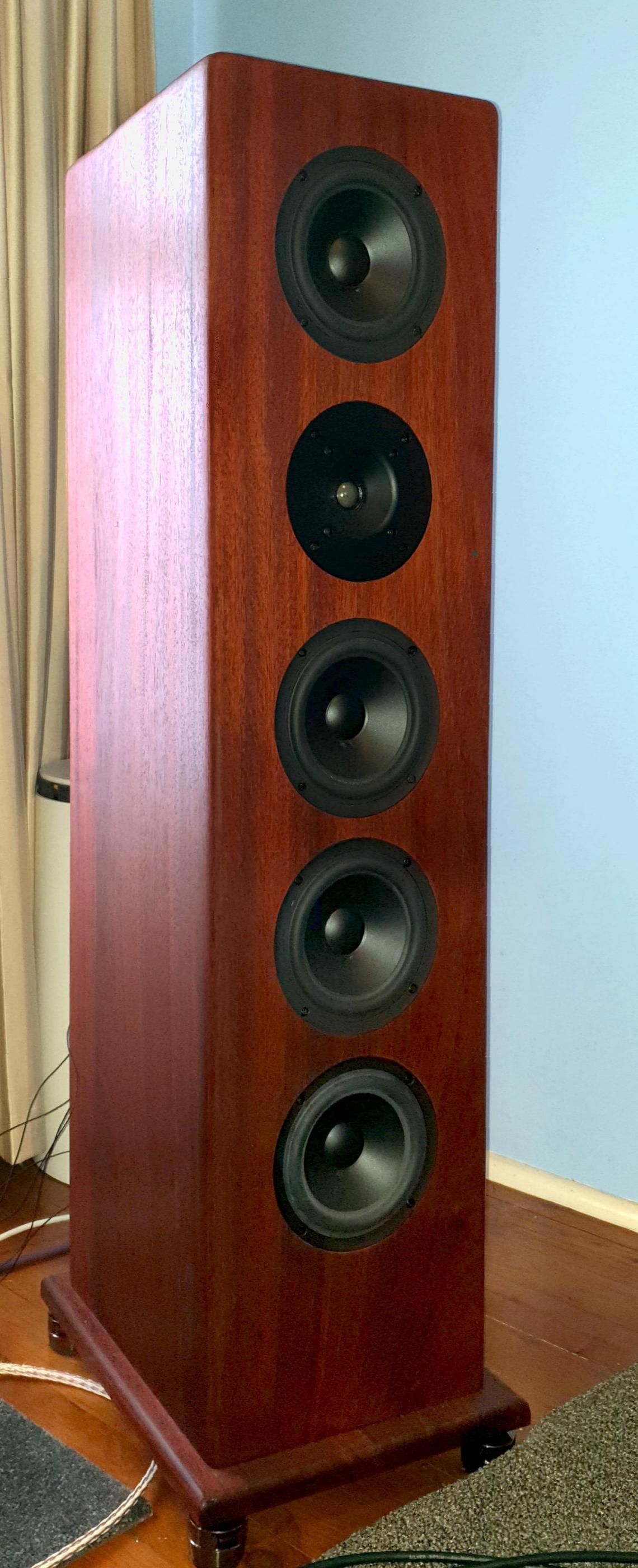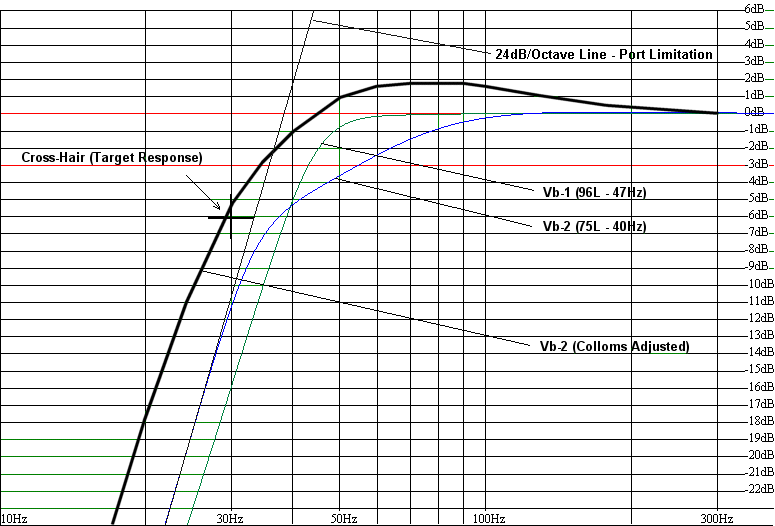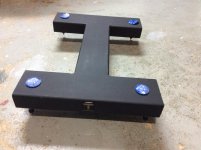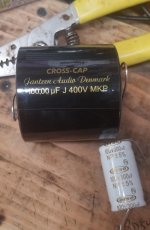Does a 3/8" round-over or bevel effectively decrease the baffle width? Asking for a friend.
The round over is acoustically mostly irrelevant. See Siegried Linkwitz ( Diffraction from baffle edges )
"The benefits of edge rounding come into play only when the radius is greater than 1/8th wavelength. Thus a typical 1/2 inch radius begins to diffuse the diffracted wave at frequencies above 3.4 kHz, but will decrease in relevance at higher frequencies, when the driver illuminates less of the edge due to its increasing directivity. With most speaker cabinets the radius or chamfer is acoustically too small and is primarily cosmetic."
No. It also lends only a small improvement to higher frequency diffraction effects. A chamfer can also be used.
dave
The round over is acoustically mostly irrelevant. See Siegried Linkwitz ( Diffraction from baffle edges )
"The benefits of edge rounding come into play only when the radius is greater than 1/8th wavelength. Thus a typical 1/2 inch radius begins to diffuse the diffracted wave at frequencies above 3.4 kHz, but will decrease in relevance at higher frequencies, when the driver illuminates less of the edge due to its increasing directivity. With most speaker cabinets the radius or chamfer is acoustically too small and is primarily cosmetic."
Thank you both.
I noticed one build used 32mm MDF and so to keep the internal volume the same, the front baffle ended up being 14mm wider than the plan. I think they beveled the baffle. Just curious if that had the effect of returning the baffle towards the original plan width.
I visited Greg H. on Saturday, he has built what I believe are the most expensive Elsinores so far. It is made of Sout African hardwood called Padouk. It cost around AUD $8000 just for the boxes and near AUD $11,000 in total. They replaced a pair of speakers made in Denmark that retails for AUD $83,000 - you might have fun guessing what it is and a hint is that it uses a very expensive ribbon tweeter. They are now for sale on consignment with a major hi-fi shop in Sydney. Greg sums up the Elsinores as "they do EVERYTHING!" and that is a common refrain.
Take a look below, the photo does not give full justice, but hope you like it:

Very nice .You could also use jarrah which is common in Australia and which is fantastic for speaker cabinets.It is almost ideal with a weight of 840kg per cubic metre and is short grained non-resonant timber.Here I used curly jarrah.
The round over is acoustically mostly irrelevant. See Siegried Linkwitz ( Diffraction from baffle edges )
"The benefits of edge rounding come into play only when the radius is greater than 1/8th wavelength. Thus a typical 1/2 inch radius begins to diffuse the diffracted wave at frequencies above 3.4 kHz, but will decrease in relevance at higher frequencies, when the driver illuminates less of the edge due to its increasing directivity. With most speaker cabinets the radius or chamfer is acoustically too small and is primarily cosmetic."
Except for the fact that diffraction generates a pass-band effect that extends both up and down in frequency. (..it's not "discreet".)
In other words: it's still relevant.
-of course it should also be more than 1/2 radius. (..practically speaking: the larger the better.)
There was a thread on chamfer vs. round-over not that long ago. If I remember correctly: chamfer was preferred - producing better results. (..and presumably chamfer with a round-over would be at least as good as chamfer alone.)
Last edited:
Very nice .You could also use jarrah which is common in Australia and which is fantastic for speaker cabinets.It is almost ideal with a weight of 840kg per cubic metre and is short grained non-resonant timber.Here I used curly jarrah.
.thumb.JPG.ecbd643a85b69b29e6ef27171135c3ff.JPG)
Very nice looking.
Very nice looking.
Yes but in a way wasted on the Meniscus Kairos.Which is pretty decent sounding but they need power and current and I was hoping to avoid that.I should have built the Elsinores.I will get around to it eventually.
Yes but in a way wasted on the Meniscus Kairos.Which is pretty decent sounding but they need power and current and I was hoping to avoid that.I should have built the Elsinores.I will get around to it eventually.
You certainly have the skills to get a nice pair built.
They look amazing. Very understated. I think I need to get busy and make bases to elevate my Mk5's in the same fashion.
irext:
This may not appeal to you, but I had custom Sound Anchor stands made for my Elsinores. They are about 90mm tall (including spikes) and do the job quite nicely. The price was about $320 (US), delivered (albeit within the US).
Regards,
Scott
zman01:
As it happens, yes. I'm in the process of repositioning my Elsinores following a music room renovation, and I haven't reseated them on the stands yet. The stands exactly fit the base of my Elsinores, and the deformed blue discs on the top are sorbothane-like absorbers that Sound Anchor supplied with the stands. They do a nice job.
Regards,
Scott
As it happens, yes. I'm in the process of repositioning my Elsinores following a music room renovation, and I haven't reseated them on the stands yet. The stands exactly fit the base of my Elsinores, and the deformed blue discs on the top are sorbothane-like absorbers that Sound Anchor supplied with the stands. They do a nice job.
Regards,
Scott
Attachments
The round over is acoustically mostly irrelevant. See Siegried Linkwitz ( Diffraction from baffle edges )
"The benefits of edge rounding come into play only when the radius is greater than 1/8th wavelength. Thus a typical 1/2 inch radius begins to diffuse the diffracted wave at frequencies above 3.4 kHz..."
I think we have two different issues here, one is the diffraction effects that Linkwitz covers quite well and I have some experience with this, but from a slightly different angle. Take a typical tweeter with a typical 104mm diameter and mount that on a baffle of at least half a square meter, measure it flush mount and not flush mounted. Even if the mounting flange is only 4mm proud when not flush mounted, the measurement will be less smooth and more irregular than when flush mounted.
But when it comes to Elsinores I am not so concerned about that, the waveguides needs to be flush mounted (and they are), so beveled edges are not going to be a significant factor.
What I am concerned about is the diffraction loss by reducing the front panel area, particularly the width of the box. Here we are talking about the gradual transition from half space to full space resulting in a theoretical 6dB drop and hence centered around 400-500Hz. The designer makes allowance for this in the crossover and integration of the drivers in the box.
If you reduce the baffle area/width, then looking at "L1" specified at 3.9mH or 4mH, in theory to correct for that, the inductor value should be reduced to maybe 3.5mH. But the the theoretical 6dB diffraction loss is not gradual and few designers correct for the full 6dB (more like 3-5dB range) because around 150Hz you see the influence of "room gain" due to room boundaries (these eventually in theory will see a 10dB gain, but this is typically below 20Hz, so you don't get the full benefit of that, but 6-8dB depending on what sort of LF extension you have).
The result is likely less output centered around 500Hz. To compensate and increase correction for diffraction loss, decrease the value of "L1" accordingly. If you want to spend time and adjusting that by ear by listening to music that will impact there, then be my guest. I would try 3.5mH instead of the recommended 3.9mH - then report back here. But since the radius I have seen are not more than 5-6mm, then I think that all is OK as it stands.
Cheers, Joe
new gear to run the elsinores
hey all,
sorry if this hijacks the thread from the diffraction discussion, but i just had to gush!
i just received a Rogue Audio RP-1 today and it's singing along driving a Nord Class D amp. this preamp sounds amazing! these speakers just reveal so much about the upstream gear! i've run them with no less than 4 different amps and all have shown so much difference in sound, which I attribute to the revealing nature of these speakers. just amazing!
cheers all and love this thread!
Scott
Duvall, WA
hey all,
sorry if this hijacks the thread from the diffraction discussion, but i just had to gush!
i just received a Rogue Audio RP-1 today and it's singing along driving a Nord Class D amp. this preamp sounds amazing! these speakers just reveal so much about the upstream gear! i've run them with no less than 4 different amps and all have shown so much difference in sound, which I attribute to the revealing nature of these speakers. just amazing!
cheers all and love this thread!
Scott
Duvall, WA
zman01:
As it happens, yes. I'm in the process of repositioning my Elsinores following a music room renovation, and I haven't reseated them on the stands yet. The stands exactly fit the base of my Elsinores, and the deformed blue discs on the top are sorbothane-like absorbers that Sound Anchor supplied with the stands. They do a nice job.
Regards,
Scott
Thanks for sharing the pic and some details. Those stands look well made and strong.
I am thinking of housing the cross overs inside the stands (approx 10-11 cm height altogether).
Any thoughts on adding a roundover to, rather than carving it from the existing baffle for this purpose?What I am concerned about is the diffraction loss by reducing the front panel area, particularly the width of the box.
Wasn't the idea of room gain in typical listening rooms debunked?the full 6dB (more like 3-5dB range) because
Question about caps, specifically C3, Joe specified 300uF, and in note 4 suggests that 3, 100uF or 2 150uF get used. For what ever reason on my first go around sourcing and ordering I picked up 6 Jantzen Audio 100uF 400V cross-caps and forgot to check the box for ordered in my BOM, next day i ordered 2 300uF 100V erse caps.. Deleverys all came (Wave guides look fantastic!!) And organizing I see my duplication...
Which is better to use?
Which is better to use?
Attachments
Wasn't the idea of room gain in typical listening rooms debunked?
How? Is it room gain that has been debunked or is it the 'typical' part that is?
The 10dB of gain is very real (it just happens a bit too low), just measure the speaker in the nearfield where it becomes quasi-anechoic, then measure it in the room where the boundaries contain the low frequencies because at LF the radiation becomes increasing spherical. I often have seen 6-7dB increase around 30Hz. This is why Bessel alignments do well in real rooms, their falloff of the 2Pi response matches what the room does. Butterworth (ported) and Chebychev (sealed) may well have a peak (not an actual peak, but that is what a rise before falloff is called). Second-Order Butterworth does OK too.
But this, of course, all depends on just where in the room the speaker is placed, so maybe it is the 'typical' part that has been debunked?
This is from Martin Colloms "High Performance Loudspeakers" Sixth Edition:
An externally hosted image should be here but it was not working when we last tested it.
Here is an explanation that was provided some years ago and seems equaloly solid today:
"This graph is only a guide. But it indicates a rising response at low frequencies. As speakers descend in frequency they become increasingly omni-directional. This means they become, gradually, a spherical radiator. The increased energy then gets bounces back into the room. The above shows the average room corrected response. This now needs to be superimposed on a standard 2Pi response, and we get the following results."
Here is an example of how it modifies the 2Pi response, which is just as well, or most of our speakers would be lacking seriously in bass:

.
Last edited:
- Home
- Loudspeakers
- Multi-Way
- The "Elsinore Project" Thread

